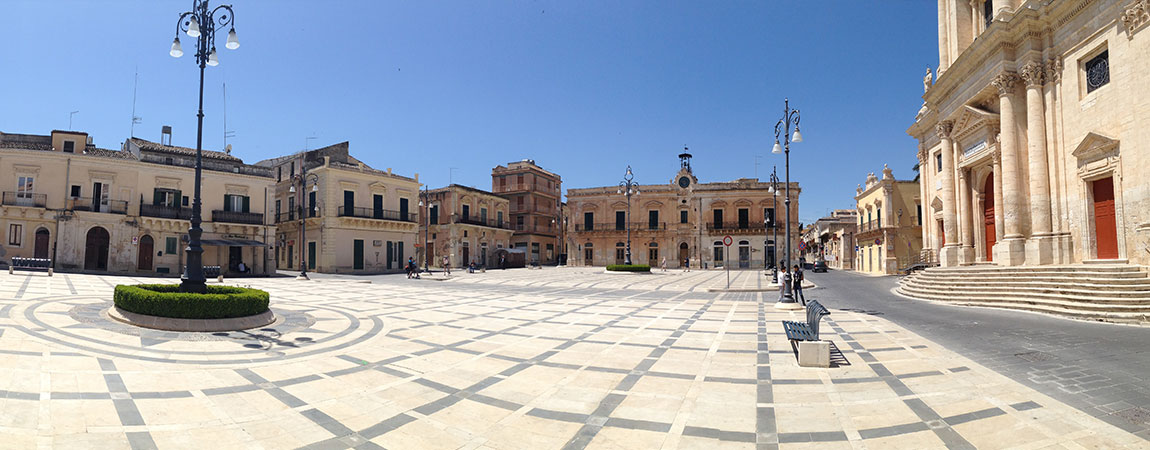
Rosolini is a feudal village in the province of Syracuse, built in the fifteenth century after the marriage of Antony Platamon e Margaret DePodio. The Platamone family had very ancient origins, even dating back to the distant Greek past of the island. In the fifteenth century the members constituted one of the most influential and powerful families in the province of Catania and the marriage was an opportunity to extend their domains: in fact, as her dowry, Margherita brought the territory on which Rosolini stands today.
In 1485 the Castle was built. For its construction it was necessary to request a precise concession from Frederick the Catholic because the territory was part of the appurtenances due to the noble lords of Noto. Despite the discontent of the nearby city, the Platamones were initially given the opportunity to establish a new fiefdom and a new village. However, the concession was revoked after only two years and the dispute between the Platamones and the nobles of Noto went on for centuries.
Nuova Rosolini was born in 1700
In 1712, the prince of Lardaria, don Francesco Moncada Cirino, after marrying the heir of the Platamon, Eleanor, obtained the so-called "Licentia Populandi“: concession of Kingdom of Sicily which allowed feudal barons to populate a country.
Thus began the reconstruction of the new village. With the feudal concession, Francesco Moncada secured the prerogatives of imposing taxes on his subjects, of administering civil and criminal justice, of managing civic offices and feudal life. The castle, built at the end of the fifteenth century, was enlarged and restructured. Churches and palaces were built, as well as humbler homes for the subjects of the feud.
The ancient past of Rosolini
The new city of Rosolini, as it was defined starting from 1712, actually has a very ancient history behind it that dates back to the prehistoric era. The archaeological finds of the Paleolithic site of Cava Grande and Caverna Lazzaro, necropolis of the Bronze Age demonstrate, are clear and precious testimony.
The Romans who settled there called it Rus Helorinum area. With the fall of Rome, the area was conquered by the Vandals, and then by the Arabs, who called it Raalsenem. The Normans brought the feudal system to southern Italy and, as we have also seen in Rosolini, until the unification of Italy in 1861.
Rosolini, as it is today
Rosolini's economy has always been and still is predominantly agricultural. Carob trees, vines, wheat and olives are grown here. The ancient craft traditions of basket makers, stonecutters, carpenters and blacksmiths continue to be preserved.
The historic center of the caramel-colored city, as it is defined, is characterized by a dense tangle of streets with buildings that keep the charm of the past intact and many restaurants, cafes, boutiques, wine bars and restaurants hidden in the alleys.
The main meeting place of the city is Piazza Garibaldi, while Savoy course, is a privileged place to stroll. The park dedicated to Pope John Paul II, with a play area for children, is the place that the inhabitants assiduously frequent to relax in a green and pleasant space.
The most important monuments
The mother church is dedicated to San Giuseppe and stands out for its splendid Baroque façade and the splendid frescoes and paintings that can be admired inside. The church was built in 1840 to a design by the famous Syracusan architect Pompeo Picherali.
They also deserve a mention Church of the Most Holy Crucifix, built in the first part of the 1700s and completely demolished and rebuilt, with a different structure and style, in 1930; and the Ethnographic Museum of G. Savarino which tells the story of the origins of Rosolini and its local traditions linked to peasant culture.
The surroundings of Rosolini
Rosolini is located near Ispica and Noto, famous baroque city, Modica, Ragusa and Syracuse and to wonderful beaches Marzamemi. Nearby you can visit important archaeological sites and admire the ancient aqueduct Roman Cansisina.
Those who visit the city of Rosolini and the entire area of Baroque Sicily cannot fail to taste the tasty delicacies of the area, such as ravioli filled with fresh ricotta, handmade cavatelli, mustazzoli, as well as the famous Sicilian sweets almonds, cannoli, granita with ice cream and much more.
Rosolini's Grain Palio
Rosolini is famous for the Palio del Grano, an important event created to celebrate the town's ancient baronial past. The event is characterized by the suggestive procession in historical costumes and by the many exhibitions of local crafts.
Several masters of the Madonnari art show off their skills and numerous stalls offer visitors delicious dishes and the traditional Cucca, a typical Rosolini dish consisting of a baked pastry filled with cheese and sausage.
© Image by David Mauro, CC BY-SA 4.0, via Wikimedia Commons









